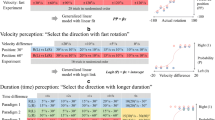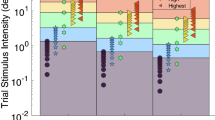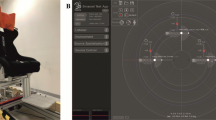Abstract
Two vestibular signals, rotational and inertial cues, converge for the perception of complex motion. However, how vestibular perception is built on neuronal behaviors and decision-making processes, especially during the simultaneous presentation of rotational and inertial cues, has yet to be elucidated in humans. In this study, we analyzed the perceptual responses of 20 participants after pairwise rotational experiments, comprised of four control and four test sessions. In both control and test sessions, participants underwent clockwise and counterclockwise rotations in head-down and head-up positions. The difference between the control and test sessions was the head re-orientation relative to gravity after rotations, thereby providing only rotational cues in the control sessions and both rotational and inertial cues in the test sessions. The accuracy of perceptual responses was calculated by comparing the direction of rotational and inertial cues acquired from participants with that predicted by the velocity-storage model. The results showed that the accuracy of rotational perception ranged from 80 to 95% in the four control sessions but significantly decreased to 35 to 75% in the four test sessions. The accuracy of inertial perception in the test sessions ranged from 50 to 70%. The accuracy of rotational perception improved with repetitive exposure to the simultaneous presentation of both rotational and inertial cues, while the accuracy of inertial perception remained steady. The results suggested a significant interaction between rotational and inertial perception and implied that vestibular perception acquired in patients with vestibular disorders are potentially inaccurate.



Similar content being viewed by others
Data Availability
No datasets were generated or analysed during the current study.
References
Angelaki DE, Cullen KE. Vestibular system: the many facets of a multimodal sense. Annu Rev Neurosci. 2008;31:125–50. https://doi.org/10.1146/annurev.neuro.31.060407.125555.
Keshavarzi S, Velez-Fort M, Margrie TW. Cortical integration of vestibular and visual cues for navigation, visual processing, and perception. Annu Rev Neurosci. 2023;46:301–20. https://doi.org/10.1146/annurev-neuro-120722-100503.
Frank SM, Greenlee MW. The parieto-insular vestibular cortex in humans: more than a single area? J Neurophysiol. 2018;120:1438–50. https://doi.org/10.1152/jn.00907.2017.
Laurens J, Angelaki DE. The functional significance of velocity storage and its dependence on gravity. Exp Brain Res. 2011;210:407–22. https://doi.org/10.1007/s00221-011-2568-4.
Merfeld DM, Zupan L, Peterka RJ. Humans use internal models to estimate gravity and linear acceleration. Nature. 1999;398:615–8. https://doi.org/10.1038/19303.
Yakusheva TA, Shaikh AG, Green AM, Blazquez PM, Dickman JD, Angelaki DE. Purkinje cells in posterior cerebellar vermis encode motion in an inertial reference frame. Neuron. 2007;54:973–85. https://doi.org/10.1016/j.neuron.2007.06.003.
Newlands SD, Abbatematteo B, Wei M, Carney LH, Luan H. Convergence of linear acceleration and yaw rotation signals on non-eye movement neurons in the vestibular nucleus of macaques. J Neurophysiol. 2018;119:73–83. https://doi.org/10.1152/jn.00382.2017.
Porter KB, Caplovitz GP, Kohler PJ, Ackerman CM, Tse PU. Rotational and translational motion interact independently with form. Vision Res. 2011;51:2478–87. https://doi.org/10.1016/j.visres.2011.10.005.
Chen A, DeAngelis GC, Angelaki DE. Convergence of vestibular and visual self-motion signals in an area of the posterior sylvian fissure. J Neurosci. 2011;31:11617–27. https://doi.org/10.1523/JNEUROSCI.1266-11.2011.
Cheng Z, Gu Y. Distributed representation of curvilinear self-motion in the macaque parietal cortex. Cell Rep. 2016;15:1013–23. https://doi.org/10.1016/j.celrep.2016.03.089.
Deco G, Rolls ET. Decision-making and Weber’s law: a neurophysiological model. Eur J Neurosci. 2006;24:901–16. https://doi.org/10.1111/j.1460-9568.2006.04940.x.
Nouri S, Karmali F. Variability in the vestibulo-ocular reflex and vestibular perception. Neuroscience. 2018;393:350–65. https://doi.org/10.1016/j.neuroscience.2018.08.025.
Diaz-Artiles A, Karmali F. Vestibular precision at the level of perception, eye movements, posture, and neurons. Neuroscience. 2021;468:282–320. https://doi.org/10.1016/j.neuroscience.2021.05.028.
Seemungal BM. The cognitive neurology of the vestibular system. Curr Opin Neurol. 2014;27:125–32. https://doi.org/10.1097/WCO.0000000000000060.
Choi JY, Koo YJ, Song JM, Kim HJ, Kim JS. Effect of a false inertial cue in the velocity-storage circuit on head posture and inertia perception. J Neurosci. 2023;43:1530–9. https://doi.org/10.1523/JNEUROSCI.1148-22.2023.
Choi JY, Park YM, Lee SH, Choi J, Hyun SW, Song JM, Kim HJ, Oh HJ, Kim JS. Linear vertigo in benign paroxysmal positional vertigo: prevalence and mechanism. Cerebellum. 2021;20:160–8. https://doi.org/10.1007/s12311-020-01196-6.
Choi JY, Glasauer S, Kim JH, Zee DS, Kim JS. Characteristics and mechanism of apogeotropic central positional nystagmus. Brain. 2018;141:762–75. https://doi.org/10.1093/brain/awx381.
Kwon H, Kwon E, Kim HJ, Choi JY, Kim JS. Vestibular syncope: clinical characteristics and mechanism. Ann Clin Transl Neurol. 2022;9:1616–25. https://doi.org/10.1002/acn3.51661.
Kwon E, Lee JY, Kim HJ, Choi JY, Kim JS. Can dyssynergia of vestibulosympathetic and baroreflexes cause vestibular syncope? the hypothesis based on the velocity-storage function. Cerebellum. 2022;21:244–52. https://doi.org/10.1007/s12311-021-01296-x.
Lee B, Kim MK, Yun SY, Lee ES, Kim HJ, Choi JY and Kim JS. Periodic vertigo and downbeat nystagmus while supine: Dysfunction of Purkinje cells coding gravity. Ann Clin Transl Neurol. 2023. https://doi.org/10.1002/acn3.51883
Shemesh AA, Kocoglu K, Akdal G, Ala RT, Halmagyi GM, Zee DS, Otero-Millan J. Modeling the effect of gravity on periodic alternating nystagmus. J Neurol Sci. 2022;442:120407. https://doi.org/10.1016/j.jns.2022.120407.
Ivanenko YP, Grasso R, Israel I, Berthoz A. The contribution of otoliths and semicircular canals to the perception of two-dimensional passive whole-body motion in humans. J Physiol. 1997;502(Pt 1):223–33. https://doi.org/10.1111/j.1469-7793.1997.223bl.x.
MacNeilage PR, Turner AH, Angelaki DE. Canal-otolith interactions and detection thresholds of linear and angular components during curved-path self-motion. J Neurophysiol. 2010;104:765–73. https://doi.org/10.1152/jn.01067.2009.
Kim HJ, Kim JS, Choi KD, Choi SY, Lee SH, Jung I, Park JH. Effect of self-treatment of recurrent benign paroxysmal positional vertigo: a randomized clinical trial. JAMA Neurol. 2023;80:244–50. https://doi.org/10.1001/jamaneurol.2022.4944.
Holly JE, Cohen HS, Masood MA. Assessing misperception of rotation in benign paroxysmal positional vertigo with static and dynamic visual images. J Vestib Res. 2019;29:271–9. https://doi.org/10.3233/VES-190676.
Baloh RW. Clinical practice Vestibular neuritis. N Engl J Med. 2003;348:1027–32. https://doi.org/10.1056/NEJMcp021154.
Kim JS. When the room is spinning: experience of vestibular neuritis by a Neurotologist. Front Neurol. 2020;11:157. https://doi.org/10.3389/fneur.2020.00157.
Park JY, Lee H, Kim HA. The frequency and relationship with vestibular function test results of positional preference in acute vestibular neuritis. Front Neurol. 2022;13:1033955. https://doi.org/10.3389/fneur.2022.1033955.
Funding
This study was supported by the Basic Science Research Program through theNational Research Foundation of Korea (NRF) funded by the Ministry of Science and ICT (2020R1A2C4002281).
Author information
Authors and Affiliations
Contributions
Dr. Lee and Yun analyzed the data and wrote the draft. Dr. Koo, Mrs. Song, and Dr. HJ Kim performed experiments and analyzed the data. Dr. Choi designed and conceptualized the study, interpreted the data, and wrote the manuscript. Dr. JS Kim analyzed and interpreted the data and revised the manuscript.
Corresponding author
Ethics declarations
Ethical Approval
This study followed the tenets of the Declaration of Helsinki and was performed according to the guidelines of Institutional Review Board of Seoul National University Bundang Hospital (B-2007–627-304).
Competing Interests
The authors declare no competing interests.
Additional information
Publisher's Note
Springer Nature remains neutral with regard to jurisdictional claims in published maps and institutional affiliations.
Rights and permissions
Springer Nature or its licensor (e.g. a society or other partner) holds exclusive rights to this article under a publishing agreement with the author(s) or other rightsholder(s); author self-archiving of the accepted manuscript version of this article is solely governed by the terms of such publishing agreement and applicable law.
About this article
Cite this article
Lee, JY., Yun, SY., Koo, YJ. et al. Disrupted Rotational Perception During Simultaneous Stimulation of Rotation and Inertia. Cerebellum (2024). https://doi.org/10.1007/s12311-024-01698-7
Accepted:
Published:
DOI: https://doi.org/10.1007/s12311-024-01698-7




